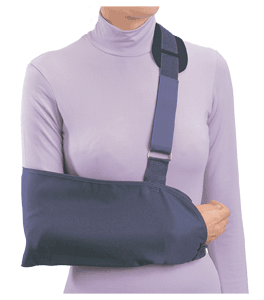
Introduction
This DonJoy sling is a high quality, durable polycotton sling with contact closure adjustment on shoulder and body straps. Fits right or left arm and helps to prevent rotation of the shoulder.
Indications
Used after surgery for acute rotator cuff repairs, shoulder subluxations or dislocations in young patients. It is very comfortable for clavicle fractures (broken collar bones) on it own or in conjunction with the Universal Clavicle.
• Clavicle fractures or dislocations
• Undisplaced radial head fractures
• Awaiting treatment for displaced radial head fractures
• Humeral lesions
• Paralysis (acute phase)
• Hemiplegia (acute phase)
• Clavicle fracture
• AC dislocation
Information on Ordering
Universal left and right.
Measure length of arm from tip of olecranon to the 5th metacarpophalangeal joint.
XS = <27.5 cm
S = 27.5- 32.5 cm
M = 32.5-37.5 cm
L = 37.5-45 cm
XL = 45-50 cm
Innovations
• Shoulder pad for comfort
• Five sizes
• Lifts arm and shoulder for immobilisation
• Fits either left or right
The role of the Sling in Hemiplegia to prevent GHS
OrthopaedicsAndTrauma.com asked Giles Head of The Keith James Physiotherapy Clinic Bristol. for advice on the use of the arm sling for Glenohumeral subluxation (GHS). Giles said: "GHS is a factor associated with shoulder pain development and with arm motor recovery and should be treated in the acute stage of hemiplegia".
Traditionally a sling is used and a radiograph taken to confirm the support has been effective. Physiotherapy is necessary to prevent contractures around the elbow and wrist. The Ultrasling II seen lower down on the Upper Extremity Post-Op Brsces is probably the prefered brace for this condition as it will support a subluxed shoulder and a drop wrist at the same time l (Paci M, Nannetti L, Taiti P, Baccini M, Rinaldi L. Shoulder subluxation after stroke: relationships with pain and motor recovery. Physiother Res Int. 2007 Jun;12(2):95-104.)
Although the studies are small and few a review of current literature cannot support the use of a sling in the chronically subluxed and painful shoulder on the side of the hemiplegia after stroke. There is some evidence that strapping the shoulder delays the onset of pain but does not decrease it, nor does it increase function or adversely increase contracture. (Ada L, Foongchomcheay A, Canning C. Supportive devices for preventing and treating subluxation of the shoulder after stroke. Cochrane Database Syst Rev. 2005 Jan 25;(1):CD003863.)